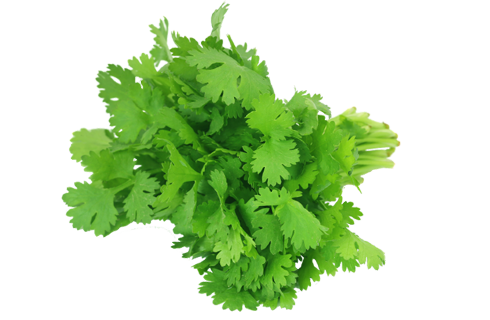
- Product name: Coriander Plant
- Available Variety: Coriander plant & Cilantro plant
- HS Code: 0709.50.10
- Package:
- As per client requirements.
- Availability: Year Around
- Shipping: Sea Shipment and Air shipment
Flavor Profile
- Fresh and Citrusy: Coriander leaves have a fresh and bright flavor profile with hints of citrus. They offer a unique combination of tanginess, herbaceousness, and slight sweetness.
- Aromatic and Fragrant: Coriander leaves are highly aromatic, releasing a pleasant fragrance when crushed or chopped. The aroma adds depth and complexity to dishes.
Health Benefits
- Nutrient-Rich: Coriander leaves are packed with essential nutrients. They are a good source of vitamins A, C, and K. They also provide minerals like potassium, calcium, and iron.
- Antioxidant Properties: Coriander leaves contain antioxidants, including flavonoids and phenolic compounds. These antioxidants help protect the body against oxidative stress, reducing the risk of chronic diseases and supporting overall health.
- Digestive Health: Coriander leaves have been traditionally used to support digestive health. They contain compounds that may help alleviate digestive issues such as bloating, gas, and indigestion.
- Anti-Inflammatory Benefits: Some compounds found in coriander leaves, such as linoleic acid and cineole, have anti-inflammatory properties. These properties may help reduce inflammation in the body and contribute to overall wellness.
- Detoxification Support: Coriander leaves are believed to have mild detoxifying properties. They may help promote the elimination of toxins from the body and support the proper functioning of the liver.
Nutritional Value
|
Nutrient |
Amount |
|
Calories |
23 kcal |
|
Carbohydrates |
3.67 g |
|
Protein |
2.13 g |
|
Fat |
0.52 g |
|
Fiber |
2.8 g |
|
Vitamin A |
6748 IU |
|
Vitamin C |
27 mg |
|
Vitamin K |
310 µg |
|
Calcium |
67 mg |
|
Iron |
1.77 mg |
|
Magnesium |
26 mg |
|
Phosphorus |
48 mg |
|
Potassium |
521 mg |
* Nutritional values may vary depending on the specific brand and preparation method. It's always advisable to check the label for accurate information.
Popular recipes of fresh coriander leaves:
Coriander Chutney:
- Blend fresh coriander leaves, green chilies, ginger, garlic, lemon juice, salt, and a pinch of sugar in a food processor until smooth.
- Adjust the consistency by adding a little water if needed.
- Serve as a condiment with snacks like samosas, pakoras, or as a spread for sandwiches.
Cilantro Lime Rice:
- Cook white rice according to package instructions.
- Finely chop fresh coriander leaves and mix them into the cooked rice.
- Squeeze fresh lime juice over the rice and season with salt.
- Fluff the rice with a fork to distribute the flavors evenly.
- Serve as a side dish with Mexican or Asian-inspired meals.
Coriander Pesto:
- Blend fresh coriander leaves, garlic, pine nuts, Parmesan cheese, olive oil, lemon juice, salt, and pepper in a food processor until well combined.
- Use the pesto as a sauce for pasta, as a spread for sandwiches, or as a marinade for grilled meats or vegetables.
- Coriander Chicken Curry:
- In a pan, heat oil and sauté diced onions until golden brown.
- Add minced garlic, grated ginger, and diced tomatoes, and cook until the tomatoes break down.
- Season with ground coriander, cumin, turmeric, chili powder, and salt.
- Add boneless chicken pieces and cook until they are cooked through.
- Stir in a handful of chopped coriander leaves and simmer for a few minutes.
- Serve the chicken curry with rice or naan bread.
Coriander Lime Dressing:
- In a blender, combine fresh coriander leaves, lime juice, olive oil, garlic, honey, salt, and pepper.
- Blend until smooth and creamy.
- Use the dressing to drizzle over salads, grilled vegetables, or roasted meats.
Types of Coriander cultivated in Egypt:
In Egypt, coriander leaves, also known as cilantro or Chinese parsley, are commonly cultivated and widely used in various culinary preparations.
- Regular Coriander: Regular coriander leaves have delicate, lacy foliage with a vibrant green color. They have a distinctive aroma and a fresh, citrusy flavor. Regular coriander leaves are commonly used as a garnish or ingredient in many Egyptian dishes, such as salads, soups, stews, and as a flavoring in sauces and dips.
- Vietnamese Coriander: While not exclusive to Egypt, Vietnamese coriander is sometimes cultivated and used in Egyptian cuisine. Vietnamese coriander has elongated, pointed leaves with a dark green color and reddish veins. It has a stronger flavor compared to regular coriander, with hints of peppery and citrusy notes. Vietnamese coriander is often used in salads, soups, stir-fries, and as a herb in traditional dishes.
